A self-serving state deliberately impoverishes the countryside, stifling business and sending illiteracy soaring, in favour of building skyscraper-raked metropolises admired by the foreign capitalists it woos. Welcome to the China of US academic Yasheng Huang, whose trenchant analysis of the country's 30 years of market reforms will not sit well with those betting the economic downturn is but a blip in the Asian giant's inexorable ascent.
Without root-and-branch political reform, Prof Huang argues in his book Capitalism with Chinese Characteristics, China faces "monumental odds" in rebalancing an urban, state-driven economy where consumption has been sacrificed on the altar of investment. "The next five years will be a litmus test for whether the country will emerge as another East Asian miracle or as a Latin American version of a vicious cycle of dashed expectations and perpetual turbulence," writes Prof Huang, an international management professor at the Massachusetts Institute of Technology.
Prof Huang's argument is that China's true economic miracle occurred in the 1980s due to an explosion of rural entrepreneurship as farmers who had lived through the Cultural Revolution gained confidence that starting a business would no longer mean arrest. All that changed in the political turmoil that followed the 1989 Tiananmen Square massacre of students. The former president Jiang Zemin and the former premier Zhu Rongji - who did not share the background of their predecessors running agricultural provinces - set about reversing many of the productive rural policy experiments of the previous decade, including easier access to credit.
The result, Prof Huang documents, is that household income growth has trailed GDP growth since the early 1990s. With the fruits of growth going increasingly to capital, mainly to big state-owned firms, the labour share of national income fell to 48 per cent of GDP in 2005, one of the lowest proportions in the world, from 53 per cent in 1990. Output, in short, has benefited Chinese citizens less and less, stunting private consumption and forcing Beijing to take up the slack by massively stimulating infrastructure investment.
"A central mechanism of the growth model of the 1990s was to finance state-led, urban China by heavily taxing entrepreneurial rural China," Prof Huang writes. Stephen Green, the head of China research at Standard Chartered Bank in Shanghai, says Prof Huang neglects some of the policy achievements of the 1990s, notably the overhaul of unwieldy state-owned firms and the launch of banking reforms. But he calls the book's dissection of China's reform period important, coherent and depressing.
"Perhaps its greatest contribution is to provide a comprehensive critique of a set of policies, many of which are still doing their damage, while at the same time pointing to the real source of China's growth," Mr Green said in a note to clients. Prof Huang marshals a vast array of statistics to back his argument that, in contrast to the entrepreneurial capitalism of the 1980s, the welfare of ordinary Chinese did not keep pace with GDP growth under the state-led capitalism of the 1990s.
The utilisation rate of hospital beds, for instance, peaked at 84.5 per cent in 1988. The rate fell in the 1990s as the cost of medical care became prohibitive and reached a low point of 57.4 per cent in 2002. Coincidentally or not, this was Mr Jiang's last year in power. By 2005, the rate had risen back to 62.9 per cent. "Again, as in so many other areas, the improvement coincided with the commencement of the leadership of Hu Jintao and Wen Jiabao," Prof Huang writes.
Mr Hu, the Chinese president and Communist Party chief, and Mr Wen, the premier, deserve credit in Prof Huang's eyes for beginning to repair the social safety net and reverse the neglect of the countryside. Since Mr Hu took over in 2002, inflation-adjusted rural income growth has recovered to 5.5 per cent a year from 3.8 per cent, while Mr Jiang was in office from 1989 to 2001. From 1978-1988, peasants' incomes rose 12.2 per cent a year in real terms.
More broadly, the policy platform unveiled at the five-yearly congress of the Communist Party in Oct 2007 was the most liberal and progressive in 20 years, in Prof Huang's view. But the bad news, as he sees it, is that Mr Hu and Mr Wen have achieved results by revising policy goals, rather than the administrative policy methods of the 1990s. China today still has what the professor calls a "commanding heights" economy in which the government wields enormous power and the indigenous private sector, although now entering the fourth decade of market reforms, remains conspicuously small.
"Many of the endemic problems in the Chinese economy today - massive pollution, corruption, inefficient capital deployment, land grabs and so forth - cannot be tackled without meaningful institutional reforms, in particular, reforms of Chinese political governance," Prof Huang writes. "So far, the policy rhetoric is encouraging. The issue is whether the current leaders will truly follow their policy rhetoric to its logical conclusion - empowering people through political reform."
* Reuters





